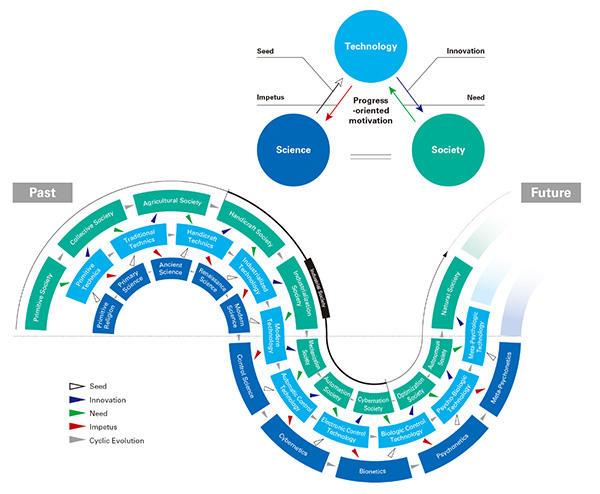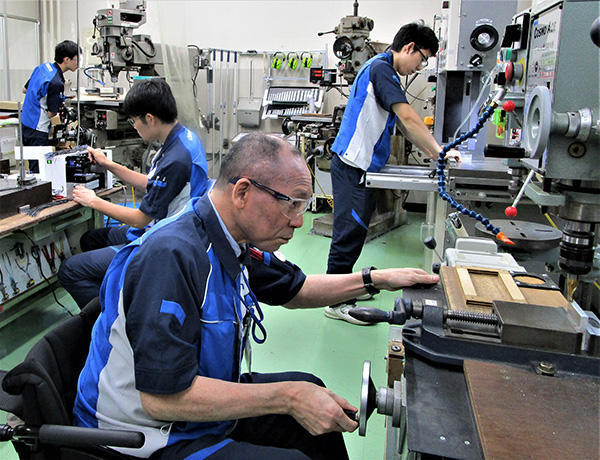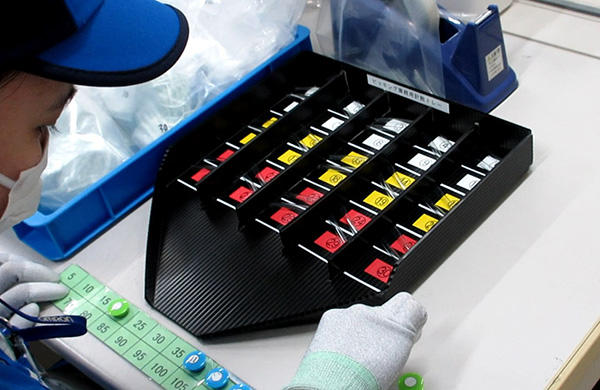
OMRON Taiyo and OMRON Kyoto Taiyo are production sites where people with disabilities constitute the core workforce. OMRON Taiyo has been employing people with disabilities for close to half a century since its founding in 1972. What was groundbreaking about the company's approach was that from the outset it aimed to use the employment of people with disabilities not just as contribution to society, but also as a way of boosting its own profitability. The company's founders believed that this approach would create work opportunities for people with disabilities and help build a better society. In this article, we introduce OMRON's efforts to create vibrant manufacturing sites that give free rein to diverse individual attributes and talents, guided by the core value of "working for the benefit of society."
ŃĆĆ
OMRON's history of employment of people with disabilities begins with the company's encounter with Japan Sun Industries, a social welfare corporation established with the aim of providing stable employment to people with disabilities and fostering their independence.
Japan Sun Industries was founded by Dr. Yutaka Nakamura, an orthopedic surgeon. Also known as the father of Japan's Paralympic movement, Nakamura pioneered the use of sports in rehabilitation for people with physical disabilities and was active in promoting disabled sports. In 1965 he founded Japan Sun Industries under the slogan: "No Charity, but a Chance!"
Nakamura believed that "there may be people with physical and mental disabilities in society, but there is no such thing as disability in jobs." He set out to find companies that would collaborate with him by providing these "jobs" rather than just financial assistance in forms such as donations. He struggled to find sympathetic partners, but one man who took up his proposal willingly was Kazuma Tateishi, the founder of OMRON.
Nakamura's philosophy resonated with that of Tateishi, and in 1972, Japan's first welfare factory employing people with disabilities was established in the city of Beppu, Oita Prefecture. Named OMRON Taiyo, the factory was jointly financed by OMRON, Japan Sun Industries, and a number of people with disabilities themselves. Thirteen years later, in 1985, second hub for employment of people with disabilities, OMRON Kyoto Taiyo, was founded in OMRON's home city of Kyoto.
Why did OMRON's founder Kazuma Tateishi decide to start employing people with disabilities? In 1959, a decade prior to OMRON Taiyo's establishment, Putting into his own words his awareness of the "pioneering spirit" and "public nature of business," Tateishi established the Corporate Motto: "To improve lives and contribute to a better society." OMRON Taiyo and OMRON Kyoto Taiyo were born out of a deep respect for humanity and a self-awareness of OMRON's role in working for the benefit of society, as encapsulated in this Corporate Motto.
Meanwhile, Tateishi and his associates at OMRON had also formulated the SINIC theory that predicts the future by reference to the interrelationship of science, technology, and society, and presented this theory at the International Future Research Conference in 1970. Based on this theory, Tateishi and OMRON predicted the advent 50 years into the future of an "autonomous society" in which individuals and society, humans and nature, and humans and machines harmonize with one another autonomously. This means that more than half a century ago, Tateishi was already predicting a future that prioritized the "autonomy of the individual" with an intrinsic respect for diverse ways of life, different value outlooks, and human dignity itself.
OMRON Taiyo and OMRON Kyoto Taiyo are a practical embodiment of the spirit of the Corporate Motto and the OMRON Principles, which seek to create on our own the kind of society predicted by the SINIC theory. They also accord with the current worldwide effort to achieve targets for the benefit of all humankind, including the idea of "leaving nobody behind" as articulated in the Sustainable Development Goals (SDGs).
 The SINIC Theory
The SINIC TheoryŃĆĆ
OMRON Taiyo and OMRON Kyoto Taiyo are distinguished by their diversified, small-lot approach to manufacturing items including sensors, relay/timer sockets, switches, power supply units, and other industrial components, as well as healthcare products such as Thermometers and blood pressure monitors. Both factories aim to place humans at the center of their operations and create manufacturing sites where every worker can continue to shine. In order to capitalize on individual potential, tasks that can be performed by each individual worker are devised in communication with the workers themselves, and improvements to operations and proficiencies are pursued on a daily basis, so the range of tasks that can be performed by people with disabilities is always expanding.
To foster the motivation and culture of continuous improvement that are so essential to successful manufacturing sites, employees themselves are given the initiative in pursuing "improvement activities." One of these activities is the enhancement of mechanical devices to support operators on the production floor. In the product packaging process, for example, the work area is located some distance away from the place where packaging materials are stored. Wheelchair users used to find moving between these two locations difficult, and also faced hazards because they could only pick up the materials if they leaned out of their wheelchairs. To address this problem, a device was installed to convey the required materials to operator's work stations automatically. This is an example of the "human-centered" approach to manufacturing site development, in which facilities are improved in order to maximize workers' potential, rather than requiring workers to adapt to the existing facilities and production lines. Both factories have pursued these kinds of improvement activities repeatedly and succeeded in not only raising the capabilities of individual employees but also strengthening product quality and boosting productivity.
 Employees Themselves Design and Manufacture the Components Needed to Improve Factory Facilities and Equipment
Employees Themselves Design and Manufacture the Components Needed to Improve Factory Facilities and EquipmentŃĆĆ
Just as each individual has a different personality, the types of disability are many and varied. OMRON Taiyo seeks to provide an environment in which every worker can shine: not just those with physical disabilities but also those with psychological and intellectual disabilities, including developmental disabilities. For this purpose, the company promotes "universal manufacturing abbreviated to 'UNIMONO' '' initiatives.
The concept behind "UNIMONO" is to create manufacturing sites where anyone with the desire to work is able to use their capabilities to the full. It involves applying universal design approaches to manufacturing sites in accordance with twelve categories based on the skills and physical functions required for each task, to enable workers to take on a wider variety of roles regardless of whether or not they have a disability.
For example, as a means to support employees with developmental disabilities to work, the company created a tool that enables the counting of "how many components have been counted how many times" while performing a certain task. By developing and using these kinds of support tools based on an understanding of the characteristics of each employee's disability, it has been possible to reduce errors and greatly improve work process quality. Another innovation that is used widely by employees with intellectual disabilities (such as autism) is the "Tell Me Sheet" Often, if a supporter simply asks such a worker if they are having any trouble, the response will be "no, it's all fine," with no further communication. The "Tell Me Sheet" allows the supporter to write an open-ended question, which is then handed to the worker who is asked to respond. The worker will often write a response that explains a problem they are facing. The "Smile Board" is used in a similar way to enable workers who struggle to communicate face-to-face to provide an honest assessment of their mood on any given day and share it with those around them. Each worker selects a symbol that expresses their mood each day on a scale of 0 to 100%, and places it on a whiteboard where it can be seen by other members of the team. This allows others immediately to grasp how the individual is feeling physically and mentally and provide support as needed.
At OMRON Taiyo, "UNIMONO'' enables team members better to understand and assist one another, and foster an environment where everyone can work productively.
 Created a Tool that Enables the Counting of "How Many Components Have Been Counted How Many Times" while Performing a Certain Task
Created a Tool that Enables the Counting of "How Many Components Have Been Counted How Many Times" while Performing a Certain TaskŃĆĆ
Created a Tool that Enables the Counting of "How Many Components Have Been Counted How Many Times" while Performing a Certain TaskOMRON Kyoto Taiyo is likewise making thoroughgoing efforts to "bring out the best in people." In order to create a safe, secure environment where every worker can shine, it is essential to monitor how workers feel. The company does this through "optimal communication" tailored to each individual. One initiative in this area is the use of a smartphone and PC app for dialogue between employees and their supervisors and the management of personal health. In many cases, this enables even workers who struggle to communicate face-to-face to engage in dialogue with relatively little stress. When a supervisor notices a change in an employee's physical or mental condition in the course of dialogue on the app, they can switch immediately to real-time dialogue including associated third parties in order to learn more about the employee's condition and concerns and respond appropriately.
What is important here is to build relationships of mutual trust through ongoing dialogue. At OMRON Kyoto Taiyo, it has become clear that these relationships form the basis of a safe, secure environment as well as promoting the growth of individual employees, their co-workers, and managerial staff, and helping to generate successful outcomes.
ŃĆĆ
Promotion of DX with a Focus on Bringing Out the Best in People
OMRON Kyoto Taiyo is also working on Digital Transformation (DX) to bring manufacturing closer to an ideal state by utilizing data from the production floor including information on production and work processes. The company has created a system for "visualizing" the manufacturing site so production progress and worker status can be ascertained in real time, thereby enabling line leaders to respond swiftly and institute recovery measures in the event of delays in production processes. The plan going forward is to conduct video checks on work processes so that unusual changes in a worker's condition can be identified through data on "process irregularities," and appropriate action can be taken to communicate with the worker, check on their health, and direct them to take breaks as needed. Moreover, analysis of the speed at which each worker performs their tasks will be used to optimize the assignment of personnel. These initiatives to create links between people and data and to capture workers "in the moment" are designed to help maintain the health and motivation of every employee, as well as to achieve ongoing improvements in production efficiency.
Producing results by focusing on people and utilizing machines and IT: this is the essence of OMRON Kyoto Taiyo's goal of "bringing out the best in people," and "manufacturing with people, machines, and IT in harmony."
Under the SINIC predictive theory, in the near future, human desires such as individual lifestyles, fulfilling lives and self-realization will be achieved, and ultimately there will be a shift to an "autonomous society" in which individuals and society, humans and nature, and humans and machines harmonize with one another autonomously. OMRON Taiyo and OMRON Kyoto Taiyo are helping to put this vision for the future into action.
In 2022, OMRON Taiyo will celebrate its 50th anniversary. OMRON will continue to work with OMRON Taiyo and OMRON Kyoto Taiyo to tackle new challenges as we move toward the "autonomous society" of the future.